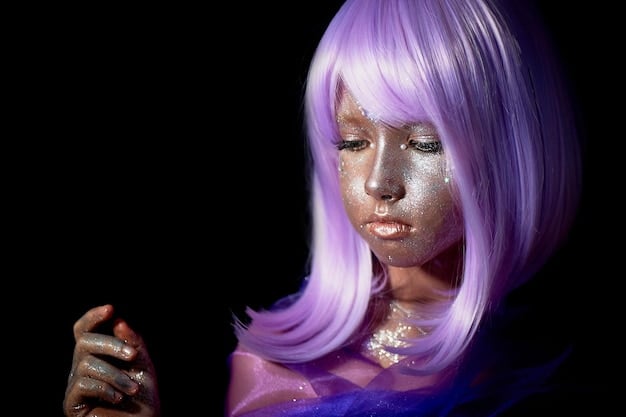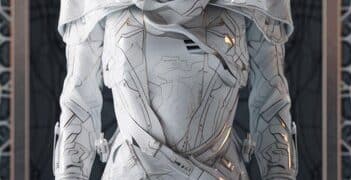Anime-Perfect Hair: Cosplay Wig Styling Secrets Revealed

Cosplay wig styling secrets involve mastering techniques like ventilation, cutting, and heat manipulation to replicate intricate anime hairstyles with authenticity and durability, ensuring characters are brought to life accurately.
For aspiring and experienced cosplayers alike, achieving the perfect look often hinges on one crucial element: the wig. Beyond simply wearing it, the art of wig styling transforms a basic piece into the iconic, gravity-defying, or intricately detailed hair of your chosen character. Dive into these Cosplay Wig Styling Secrets: Achieve Anime-Perfect Hair with These Pro Tips and Tricks, where we explore the techniques and tools that elevate your cosplay from amateur to astonishingly accurate.
Understanding Your Wig: Fiber Types and Foundations
The journey to anime-perfect hair begins long before any styling takes place. It starts with understanding the very foundation of your wig: its fiber type and construction. Not all wigs are created equal, and knowing these distinctions is crucial for successful styling. The two primary types of wig fibers you’ll encounter in cosplay are synthetic and heat-resistant synthetic, each with its own characteristics and styling limitations.
Synthetic wigs are typically made from plastic fibers like kanekalon or toyokalon. These are generally more affordable and come in a vast array of colors and styles. However, their primary limitation is heat. Regular synthetic fibers melt easily, making styling with heat tools (like straighteners or curling irons) impossible. They are best suited for characters with straight or pre-styled hair that requires minimal heat manipulation. Heat-resistant synthetic wigs, often labeled as “heat-friendly” or “futura,” offer more versatility. These fibers can withstand moderate heat, usually up to 350-400°F (175-200°C), allowing for the use of heat tools on a low setting. This opens up a world of possibilities for curling, straightening, and shaping that regular synthetic wigs cannot offer. Always check the manufacturer’s recommendations for maximum heat tolerance to avoid irreparable damage.
Cap Construction and Density
Beyond the fibers, the wig’s cap construction plays a significant role in how well it can be styled and worn. Most cosplay wigs utilize a wefted cap, where strands of hair are sewn onto elasticized strips (wefts) that are then stitched into a breathable cap. This construction provides good airflow and allows for some volume. Lace front wigs feature a sheer lace panel at the hairline, with individual hairs tied to the lace. This creates a highly natural-looking hairline, essential for characters whose hair is pulled back from the face. Lace fronts require careful application and blending but offer unparalleled realism. Finally, the density of a wig—how many fibers are packed into the cap—impacts its ability to hold complex styles and prevent track showing. A denser wig provides more hair to work with for intricate details, but can also be heavier and harder to manage.
- Synthetic Fibers: Affordable, wide color range, but sensitive to heat.
- Heat-Resistant Fibers: More versatile, can be styled with low heat, check temperature limits.
- Wefted Caps: Common, breathable, good for general styling.
- Lace Fronts: Realistic hairline, ideal for pulled-back styles, requires careful handling.
Understanding these fundamental aspects of your wig empowers you to choose the right base for your cosplay and approach styling with confidence, avoiding common pitfalls and ensuring a durable, visually stunning result. The foundation you choose dictates the potential and limitations of your wig styling journey.
Essential Tools for Wig Styling Success
Just as a painter needs their brushes, a wig stylist requires a specific arsenal of tools to craft anime-perfect hair. Having the right equipment makes a world of difference, saving you time, frustration, and potentially costly errors. Skipping crucial tools can lead to subpar results or even damage to your wig. Therefore, investing in quality tools is a foundational step in mastering wig styling.
The Basic Toolkit
At the core of any wig styling kit are a few non-negotiables. A wig head, preferably a canvas block head, is essential. It securely holds the wig, simulating a head, and allows you to work from all angles without causing damage. Pinning your wig securely to the wig head with T-pins prevents slipping and provides stability during intricate styling. Next, a good quality wide-tooth comb and a fine-tooth comb are invaluable. The wide-tooth comb is perfect for detangling without pulling or damaging fibers, while the fine-tooth comb is crucial for precision and smoothing. Sharp, dedicated wig shears are also a must. Using regular scissors can fray wig fibers, leading to an unnatural, choppy look. Wig shears are designed to cut synthetic hair cleanly, giving you more control over layering and shaping.
Advanced Styling Aids
For more advanced techniques and intricate anime styles, you’ll want to expand your toolkit further. Heat tools, such as a flat iron and curling iron (ensure they have adjustable temperature settings for heat-resistant wigs), are vital for shaping and setting styles. Always use a heat protectant spray specifically designed for synthetic wigs to minimize damage. Hairspray, particularly a strong-hold, non-flaking variety, is your best friend for defining spikes, curls, and intricate shapes. Look for products that dry clear and don’t leave a tacky residue. Fabric glue, like Aleene’s Tacky Glue, can be surprisingly useful for permanently setting small sections, attaching extensions, or reinforcing stubborn pieces. For extreme styles, a hairdryer and gel or styling paste can create gravity-defying looks. Lastly, ventilation needles, while more advanced, are used for adding or replacing individual strands of hair, perfect for creating hairlines or filling sparse areas.
- Wig Head & T-Pins: Stability and support for styling.
- Combs (Wide & Fine-Tooth): Detangling and precision.
- Wig Shears: Clean, controlled cutting of synthetic fibers.
- Heat Tools: Shaping and setting for heat-resistant wigs (with protectant).
- Strong-Hold Hairspray: Defining and holding intricate styles.
- Fabric Glue: Permanent setting and reinforcement.
As you gain experience, you’ll discover which tools best suit your personal styling methods and the demands of specific characters. Equipping yourself with these essential tools is not just about convenience; it’s about empowering your creativity and achieving professional-level results with your cosplay wigs.

Mastering the Art of Cutting and Layering
Cutting and layering are perhaps the most intimidating, yet rewarding, aspects of wig styling. It’s where you transform a generic wig into a character-specific masterpiece. Many factory wigs come with excess length and uniform layers, which rarely suit the dynamic, voluminous, or precise cuts often seen in anime. Approaching this step with confidence and a clear vision is critical to success.
The first rule of cutting is simple: always cut less than you think you need. You can always take more off, but you can’t put it back on. Begin by sectioning the wig hair, isolating the parts you intend to cut. Use hair clips to keep untouched sections out of the way. For length reduction, hold the hair straight out and snip in small, upward motions (point cutting) rather than a blunt, straight cut. Point cutting creates a softer, more natural edge and prevents a harsh, “chopped” look. This technique is particularly useful for bangs or the ends of a style.
Creating Dimension with Layers
Layering is key to adding volume, movement, and dimension to a wig, mimicking the dynamic hair of anime characters. To create layers, lift sections of hair straight up from the wig head. The higher you lift the hair before cutting, the longer the layers will be. Cut in small, vertical snips. For face-framing layers, bring sections of hair forward to the face and cut at an angle, blending naturally with the length. Always check your work by combing through and allowing the layers to fall naturally before making further cuts. It’s often helpful to look at reference images of your character from multiple angles to ensure accuracy.
Blunt bangs are a staple in many anime designs and require a slightly different approach. First, section out the desired bang area. Comb the hair straight down across the forehead. Cut conservatively, checking the length frequently against your face (or the wig head’s “face” if using a mannequin). Point cutting at an angle for the final trim helps to achieve a clean but soft line. Texturizing shears (thinning shears) can be used sparingly to remove bulk, especially in very thick wigs, or to soften harsh lines and create a more natural flow. However, use them with extreme caution, as excessive thinning can leave the wig looking sparse or damaged.
Before any major cutting, consider these tips:
- Start Slow: Always remove small amounts of hair at a time.
- Use Sharp Shears: Dull scissors fray fibers and make clean cuts impossible.
- Consult References: Keep character art or screenshots nearby for accuracy.
- Work in Sections: Clip away hair you’re not currently working on.
- Point Cutting: Creates softer edges and a more natural look than blunt cuts.
Mastering cutting and layering takes practice, but the precision and character it brings to your wig are well worth the effort. It transforms a simple wig into a tailored, authentic representation of your character’s iconic hair.
Heat Styling for Shape and Volume
Heat styling is where many anime hairstyles truly come to life. While some complex styles can be achieved with only cutting and hairspray, heat is invaluable for setting durable curls, sleek straightness, or gravity-defying volume in heat-resistant synthetic wigs. Approaching heat styling with care and understanding is paramount to success, as improper use can lead to irreparable damage to your wig fibers.
The first and most critical rule is to always verify your wig is heat-resistant. If it’s not, heat styling will melt the fibers, creating an irreversible mess. Even with heat-resistant wigs, start with the lowest possible heat setting on your flat iron or curling iron and gradually increase if needed. High heat, even on heat-resistant fibers, can cause them to become brittle or lose their natural sheen over time. A heat protectant spray designed for synthetic wigs is highly recommended. Spray a light mist over the section of hair you plan to style before applying heat; this adds a protective barrier and helps maintain the fiber’s integrity.
Curling and Straightening Techniques
For curling, section the wig hair into small, manageable pieces. Wrap each section around a curling iron, hold for a few seconds (start with 5-10, adjusting as needed), then release. Immediately pin the curl in place with a clip or bobby pin while it cools completely. This “setting” process is crucial for synthetic fibers to retain their shape. For tighter curls, use smaller sections and a smaller barrel curling iron. For looser waves, larger sections and a wider barrel work best. Once completely cool, gently release the pinned curls and finger-comb to achieve the desired look. For straightening, section the hair and slowly run a flat iron down each section, ensuring the hair passes through smoothly. Again, work in small sections and allow the hair to cool.
Achieving volume, especially at the roots, can transform a flat wig into an anime-accurate, dynamic style. Backcombing (teasing) with a fine-tooth comb is an effective technique. Lift a section of hair straight up and gently comb against the grain towards the roots. Secure with hairspray. Repeat in small sections to build volume strategically. A hairdryer can also be used with styling products like gel or mousse to create lift and hold. Apply product to the roots, then use the hairdryer on a low-medium heat setting while gently lifting and sculpting the hair with your fingers or a comb. Always let the hair cool completely in its desired shape before manipulating it further.
- Verify Heat-Resistance: Essential before using any heat tools.
- Low Heat Settings: Always start low to prevent damage.
- Heat Protectant: Spray before applying heat for fiber protection.
- Pin Curls to Cool: Allows synthetic fibers to “set” their new shape.
- Backcombing: Creates volume at the roots, secured with hairspray.
Heat styling, when done correctly, is a powerful technique for achieving the intricate and often gravity-defying hairstyles characteristic of anime. Patience and careful application will yield stunning, durable results that elevate your cosplay.
Spiking, Sculpting, and Holding Complex Styles
Many iconic anime hairstyles feature gravity-defying spikes, intricate twists, or perfectly sculpted shapes that seem impossible to achieve with human hair, let alone a wig. This is where advanced styling techniques, specialized products, and a lot of patience come into play. Mastering the art of spiking, sculpting, and holding these complex styles is where true wig wizardry shines.
The core principle behind gravity-defying styles is building a strong internal structure and reinforcing it with powerful adhesives. Hairspray, particularly a heavy-duty, fast-drying variety, is your go-to product. For prominent spikes, section off the hair you want to spike. Apply hairspray generously to the section, working it through from root to tip. As the hairspray begins to dry, mold the hair into the desired spike shape. Hold it in place until the hairspray sets. For extra stubborn spikes or those that need to defy extreme angles, a hairdryer can be used on a cool setting to speed up the drying and setting process while you hold the spike.
Using Hair Extensions and Fillers
For exceptionally large spikes or areas that require significant volume where the wig might be thin, consider using hair extensions or internal fillers. Fiberfill, craft foam, or even crumpled paper can be used as a lightweight core around which you sculpt the wig fibers. Secure these fillers into the wig cap with strong glue or by sewing them in, then comb wig hair over them, spraying and smoothing until the filler is completely concealed. This technique provides the necessary bulk without making the wig excessively heavy. For delicate or small spikes, a strong styling gel or even fabric glue applied to the tips can provide permanent hold. Apply a small amount, shape, and allow it to dry completely.
Another secret weapon for complex sculpting is the use of a “wig glue” or strong fabric adhesive. For very precise, flat sections or areas that need to be permanently held against the wig cap or other hair sections, a small amount of glue can provide a robust, long-lasting hold. Be cautious with glue; apply sparingly with a fine-tipped applicator (like a toothpick) and ensure you are happy with the placement before it dries, as it is often irreversible. Always work in small sections, allowing each part to dry and set before moving on. This layered approach to styling and setting ensures maximum durability and accuracy for even the most ambitious anime hairstyles.
- Heavy-Duty Hairspray: Essential for setting spikes and intricate shapes.
- Internal Fillers: Craft foam or fiberfill for large, voluminous sections.
- Fabric Glue/Wig Glue: For permanent, precise hold on small details.
- Work in Sections: Small, manageable sections allow for better control and drying.
- Patience is Key: Complex styles require time for setting and drying.
From the flamboyant spikes of a shonen hero to the flowing locks of a magical girl, these techniques allow cosplayers to transcend typical hair styling, bringing dynamic and true-to-character aesthetics to their creations.
Maintaining Your Wig: Storage and Care
After hours of meticulous styling, the last thing you want is for your anime-perfect wig to lose its shape, get tangled, or accumulate damage. Proper maintenance and storage are just as crucial as the styling process itself. A well-cared-for wig not only looks better for longer but also extends its lifespan, protecting your investment and hard work. Neglecting wig care can lead to matting, irreversible tangles, and a loss of style.
Regular detangling is vital, especially for long wigs. Always start detangling from the tips and work your way up to the roots, using a wide-tooth comb. Holding the wig fibers above the tangle prevents unnecessary pulling at the wig cap. For stubborn tangles, a detangling spray specifically designed for synthetic wigs can be incredibly helpful. Simply spritz the tangled area and gently comb through. Avoid harsh brushing, as this can stretch or damage the fibers.
Cleaning Wigs: When and How
While wigs don’t need to be washed as frequently as human hair, they do require cleaning, especially after prolonged wear or if they’ve accumulated product buildup. Only wash your wig when necessary to preserve its style. When washing, use cool or lukewarm water and a mild shampoo specifically formulated for synthetic wigs (or a gentle baby shampoo). Never scrub or wring the wig, as this can cause matting. Instead, gently swish it in the soapy water, focusing on areas that may have absorbed sweat or makeup. Rinse thoroughly with cool water until all shampoo is gone.
After washing, gently press out excess water with a towel; do not twist or wring. Allow the wig to air dry completely on a wig stand, away from direct sunlight or heat. Avoid blow-drying, as this can damage the fibers and alter the carefully set style. Once completely dry, you can lightly restyle if needed. For storage, a dedicated wig head or a specialized wig stand is ideal. This helps the wig maintain its shape and prevents kinks or flattening. For longer-term storage, a breathable wig bag or a shoebox can protect it from dust and light. If storing in a bag, gently place a hairnet over the styled wig to help hold the shape. Never store wigs in a crumpled heap, as this will lead to tangles and damage.
- Gentle Detangling: Always start from tips, work up, use wide-tooth comb.
- Wash When Necessary: Use cool water and mild shampoo, gentle swishing.
- Air Dry: On a wig stand, away from heat/sunlight.
- Store on Wig Head: Maintains shape, prevents kinks.
- Breathable Storage: Wig bags or shoeboxes for long-term protection.
By integrating these maintenance and storage habits into your cosplay routine, you ensure your meticulously styled wigs remain show-ready for every event, bringing your characters to life with enduring accuracy and flair.
Troubleshooting Common Wig Styling Issues
Wig styling, like any craft, comes with its share of challenges. Even with the best tools and techniques, you might encounter issues that seem to derail your vision of anime-perfect hair. Knowing how to troubleshoot common problems can save you from frustration, costly mistakes, and the need to start over. Identifying the root cause of a problem is often the first step to finding an effective solution.
One of the most frequent problems is a wig stubbornly refusing to hold a style. This can be due to several factors. Firstly, ensure you are working with a heat-resistant wig if heat is part of your styling plan. If it is heat-resistant, you might not be using enough heat, or more likely, you’re not allowing the styled section to cool completely before manipulating it. Remember the importance of pinning curls until they are stone cold. Another reason could be insufficient product. Don’t be afraid to use a strong-hold hairspray or gel generously, especially for spikes and defined shapes. Layering product, allowing each layer to dry, can build up hold.
Dealing with Tangling and Frizzing
Wigs, particularly long ones, are prone to tangling and frizzing. Frequent combing from the bottom up, as mentioned in maintenance, is crucial for prevention. If a wig is already tangled, a liberal application of detangling spray (and sometimes, fabric softener diluted in water as a last resort) can help immensely. Work in small sections, gently separating strands. Frizzing often occurs from excessive friction or heat damage. For minor frizz, a light mist of hairspray or a small amount of wig conditioner can help smooth it down. If the frizz is severe due to heat, sometimes the only solution is to trim the damaged ends. To prevent future frizz, always use a heat protectant and minimize friction.
Another common issue is an unnatural or “plastic” shine, particularly with cheaper synthetic wigs. A quick fix for this is to lightly dust the wig with baby powder or a matte setting powder. Apply sparingly with a large brush and then gently shake out any excess. This dulls the shine and gives the wig a more natural, fabric-like appearance. If you’re finding it difficult to achieve volume or hide the wig cap, consider adding extensions or wefts to sparse areas, or strategically backcombing and using hairspray underneath the top layers. Sometimes, a wig might simply be too thin for the desired style, and adding more hair is the most effective solution.
- Style Won’t Hold: Ensure heat-resistance, allow cooling, use more product.
- Tangling: Gentle detangling from tips, use detangling spray.
- Frizzing: Heat protectant, minimize friction, light hairspray or conditioner.
- Unnatural Shine: Lightly dust with baby powder or matte setting powder.
- Lack of Volume/Cap Showing: Add extensions, backcomb, or use internal fillers.
Troubleshooting is an iterative process of trial and error. By understanding these common issues and their solutions, you can approach wig styling with greater confidence, tackling obstacles head-on and ultimately achieving the anime-perfect hair your cosplay deserves.

Advanced Techniques: Ventilating and Dyeing Wigs
For the seasoned cosplayer looking to push the boundaries of realism and customization, advanced techniques like ventilating and dyeing wigs offer unparalleled control. These methods go beyond basic styling, allowing for bespoke pieces that perfectly match specific character designs or enhance the natural appearance of a wig. While more time-consuming and requiring specific tools, the results can be truly transformative, elevating your cosplay to professional levels.
Ventilating a wig involves inserting individual strands of hair into a





